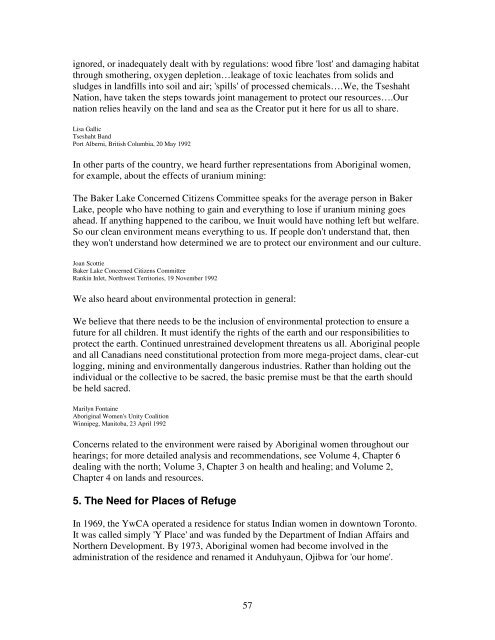2. Women's Perspectives - Christian Aboriginal Infrastructure ...
2. Women's Perspectives - Christian Aboriginal Infrastructure ...
2. Women's Perspectives - Christian Aboriginal Infrastructure ...
You also want an ePaper? Increase the reach of your titles
YUMPU automatically turns print PDFs into web optimized ePapers that Google loves.
ignored, or inadequately dealt with by regulations: wood fibre 'lost' and damaging habitat<br />
through smothering, oxygen depletion…leakage of toxic leachates from solids and<br />
sludges in landfills into soil and air; 'spills' of processed chemicals….We, the Tseshaht<br />
Nation, have taken the steps towards joint management to protect our resources….Our<br />
nation relies heavily on the land and sea as the Creator put it here for us all to share.<br />
Lisa Gallic<br />
Tseshaht Band<br />
Port Alberni, British Columbia, 20 May 1992<br />
In other parts of the country, we heard further representations from <strong>Aboriginal</strong> women,<br />
for example, about the effects of uranium mining:<br />
The Baker Lake Concerned Citizens Committee speaks for the average person in Baker<br />
Lake, people who have nothing to gain and everything to lose if uranium mining goes<br />
ahead. If anything happened to the caribou, we Inuit would have nothing left but welfare.<br />
So our clean environment means everything to us. If people don't understand that, then<br />
they won't understand how determined we are to protect our environment and our culture.<br />
Joan Scottie<br />
Baker Lake Concerned Citizens Committee<br />
Rankin Inlet, Northwest Territories, 19 November 1992<br />
We also heard about environmental protection in general:<br />
We believe that there needs to be the inclusion of environmental protection to ensure a<br />
future for all children. It must identify the rights of the earth and our responsibilities to<br />
protect the earth. Continued unrestrained development threatens us all. <strong>Aboriginal</strong> people<br />
and all Canadians need constitutional protection from more mega-project dams, clear-cut<br />
logging, mining and environmentally dangerous industries. Rather than holding out the<br />
individual or the collective to be sacred, the basic premise must be that the earth should<br />
be held sacred.<br />
Marilyn Fontaine<br />
<strong>Aboriginal</strong> <strong>Women's</strong> Unity Coalition<br />
Winnipeg, Manitoba, 23 April 1992<br />
Concerns related to the environment were raised by <strong>Aboriginal</strong> women throughout our<br />
hearings; for more detailed analysis and recommendations, see Volume 4, Chapter 6<br />
dealing with the north; Volume 3, Chapter 3 on health and healing; and Volume 2,<br />
Chapter 4 on lands and resources.<br />
5. The Need for Places of Refuge<br />
In 1969, the YwCA operated a residence for status Indian women in downtown Toronto.<br />
It was called simply 'Y Place' and was funded by the Department of Indian Affairs and<br />
Northern Development. By 1973, <strong>Aboriginal</strong> women had become involved in the<br />
administration of the residence and renamed it Anduhyaun, Ojibwa for 'our home'.<br />
57
















